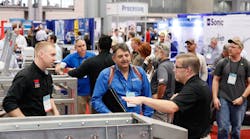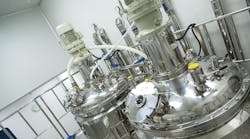One of the first-ever images of a molecular gas in which each molecule is in its lowest possible energy state. The molecules are near absolute zero, a temperature at which quantum properties reign. The image—made by detecting the absorption of laser light by the molecules—reveals their spatial distribution, with density indicated by peak height and false color. The fact that such an image can be created indicates the molecular quantum gas is dense enough to enable scientists to observe novel interactions among the molecules.
Physicists at JILA have for the first time observed chemical reactions near absolute zero, demonstrating that chemistry is possible at ultralow temperatures and that reaction rates can be controlled using quantum mechanics, the peculiar rules of submicroscopic physics. The new results and techniques, described in the Feb. 12 issue of Science,* will help scientists understand previously unknown aspects of how molecules interact, knowledge of fundamental importance to virtually every one of the physical sciences and engineering, according to a report by the National Institute of Standards and Technology (NIST).
JILA is a joint institute of the National Institute of Standards and Technology (NIST) and the University of Colorado at Boulder. An NIST theorist at the Joint Quantum Institute, a collaborative venture of NIST and the University of Maryland, also contributed to the research.
Ultracold molecules are a hot research area because they may offer more diverse insights and applications than ultracold atoms, which scientists have deftly manipulated for more than 20 years. Scientists have long known how to control the internal states of molecules, such as their rotational and vibrational energy levels. In addition, the field of quantum chemistry has existed for decades to study the effects of the quantum behavior of electrons and nuclei—constituents of molecules. But until now scientists have been unable to observe direct consequences of quantum mechanical motions of whole molecules on the chemical reaction process. Creating simple molecules and chilling them almost to a standstill makes this possible by presenting a simpler and more placid environment that can reveal subtle, previously unobserved chemical phenomena.
In conventional chemistry at room temperature, molecules may collide and react to form different compounds, releasing heat. In JILA’s ultracold experiments, quantum mechanics reigns and the molecules spread out as ethereal rippling waves instead of acting as barbell-like solid particles. They do not collide in the conventional sense. Rather, as their quantum mechanical wave properties overlap, the molecules sense each other from as much as 100 times farther apart than would be expected under ordinary conditions. At this distance the molecules either scatter from one another or, if quantum conditions are right, swap atoms. Scientists expect to be able to control long-range interactions by creating molecules with specific internal states and "tuning" their reaction energies with electric and magnetic fields.
The JILA team produced a highly dense gas of molecules consisting of one potassium atom and one rubidium atom at temperatures of a few hundred billionths of a Kelvin (nanokelvins) above absolute zero (minus 273 degrees Celsius or minus 459 degrees Fahrenheit). They found that, although molecules move slowly at ultralow temperatures, reactions can occur very quickly. However, reactions can be suppressed using quantum mechanics. For instance, a cloud of molecules in the lowest-energy electronic, vibrational and rotational states reacts differently if the nuclear spins of some molecules are flipped. If a cloud of molecules is divided 50/50 into two different nuclear spin states, reactions proceed 10 to 100 times faster than if all molecules possess the same spin state. Thus, by purifying the gas (by preparing all molecules in the same spin state), scientists can deliberately suppress reactions.
"We are observing a new fundamental aspect of chemistry—it gives us a new ‘knob’ to understand and control reactions," said NIST physicist Jun Ye, one of the lead researchers on the project, in the NIST report.
* S. Ospelkaus, K.K. Ni, D. Wang, M.H.G. de Miranda, B. Neyenhuis, G. Quéméner, P.S. Julienne, J.L. Bohn, D.S. Jin and J. Ye. Quantum-state controlled chemical reactions of ultracold KRb molecules. Science. Feb. 12, 2010.

